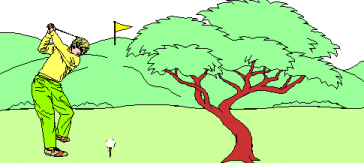
Teaching Physics with the Physics Suite
Home | Action Research Kit| Sample Problems | Resources | Product Information
Problems Sorted by Type | Problems Sorted by Subject | Problems Sorted by Chapter in UP
 |
Teaching Physics with the Physics Suite
Home | Action Research Kit| Sample Problems | Resources | Product Information |
Problems Sorted by Type | Problems Sorted by Subject | Problems Sorted by Chapter in UP |
A golfer is trying to hit a golf ball onto the green. The green is a horizontal distance s from his tee and it is up on the side of a hill a height h above his tee. When he strikes the ball it leaves the tee at an angle q to the horizontal. He wants to know with what speed, v0, the ball must leave the tee in order to reach the height h at the distance s.

where |v| stands for the absolute value of the velocity -- the speed. Consider three points of the ball's trajectory -- halfway up, at its highest point, and halfway down. Discuss the direction of the resistance force at each place. Qualitatively (do not attempt a calculation!), what will the effect of air resistance be on the ball's motion?